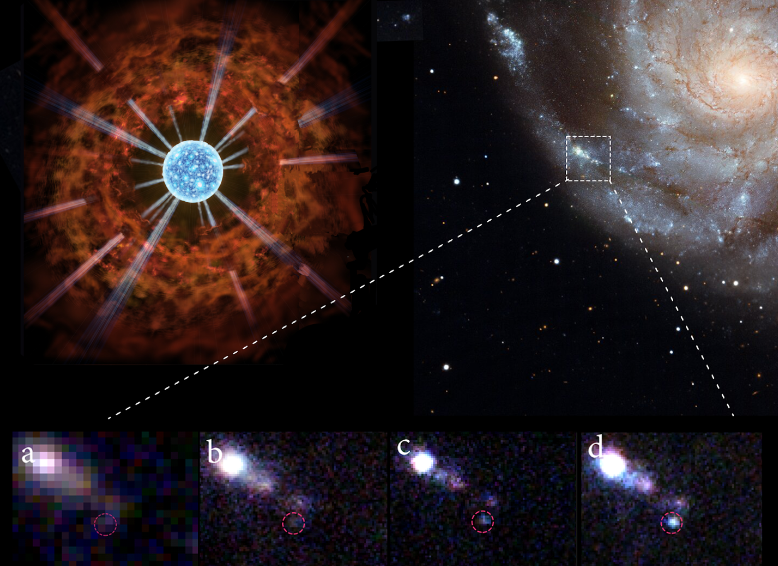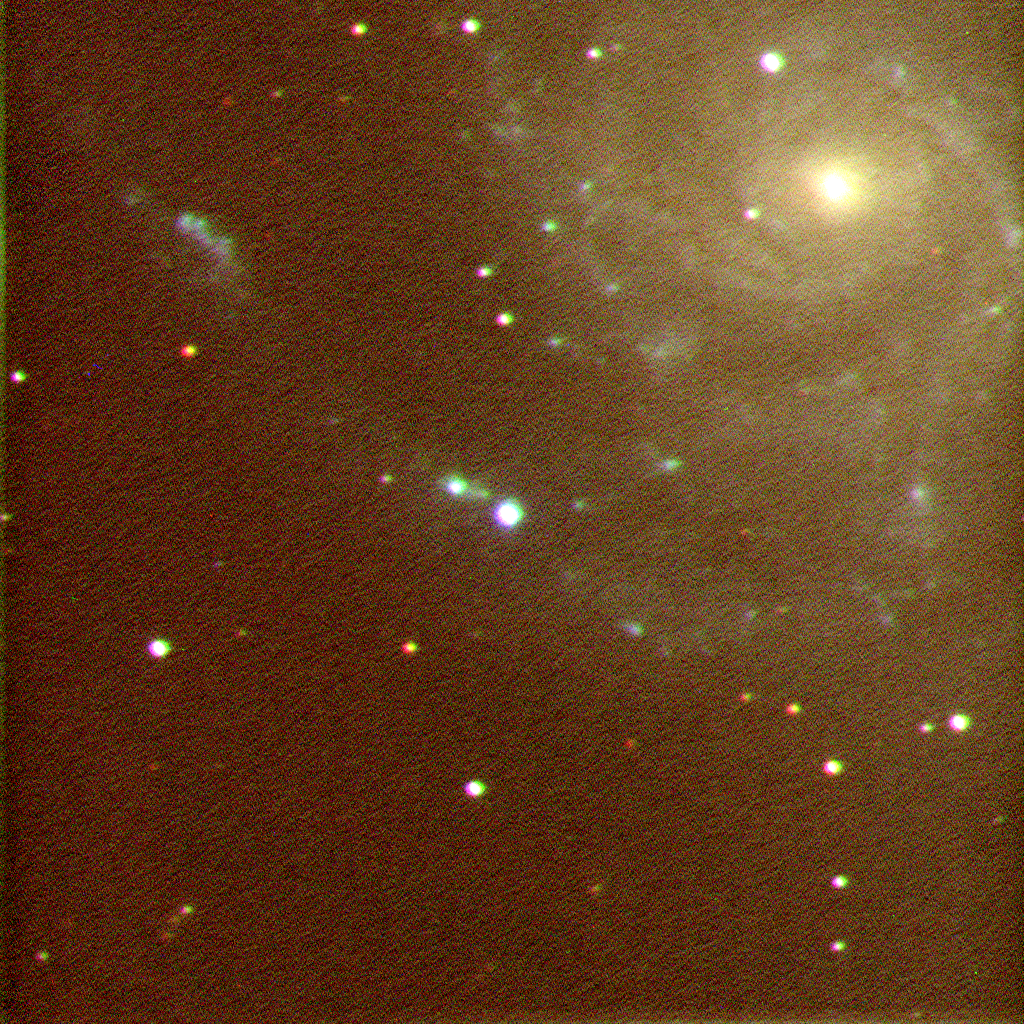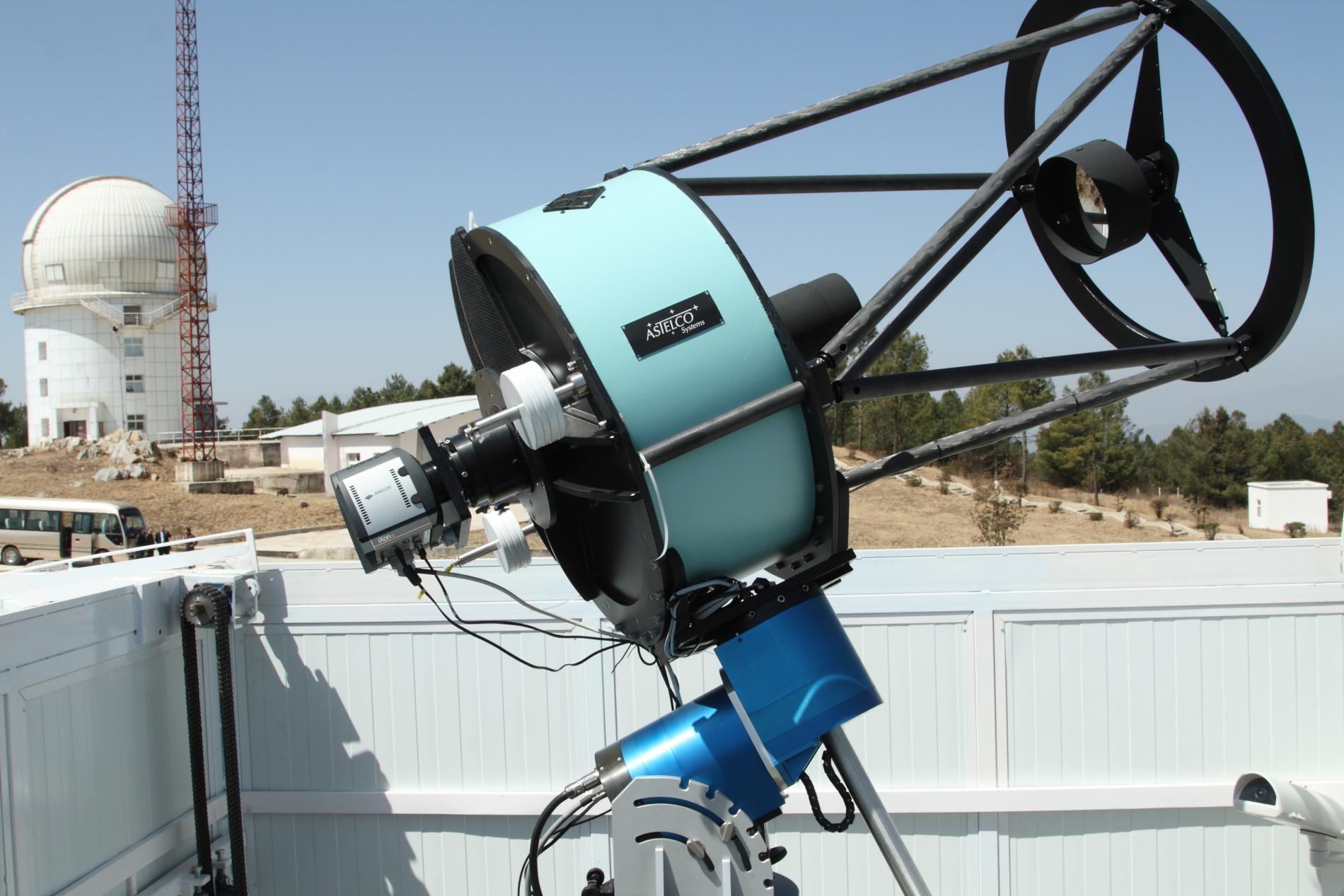Newly collapsed red supergiant star spotted
Explosion of a supergiant star detected just one hour after its collapse.
Amateur observatories have been key in detecting the supernova in its initial phases.
The IAA-CSIC participates in this study published in Nature through its global network of robotic telescopes BOOTES.
In May 2023, telescopes around the globe recorded the explosion of a red supergiant star 21 million light-years away. This is the earliest detection of a supernova phenomenon caused by the collapse of the star's core just before it dies. A team from Tsinghua University has analysed all the observations, including those from the BOOTES-4/MET telescope run by the IAA-CSIC. The results, published in the journal Nature, reveal that the star had ejected large amounts of dust in the years leading up to its death, which created a dense cloud around it that dimmed the first flash of light from the explosion.

Images a, b, c and d show the supernova explosion of SN 2023ixf and how it turns from red to blue in the different observations from 18 May (a-c) to 19 May (d) 2023. Credit: Tsinghua University
The supernova, known as SN2023ixf, was triggered when the rate of fusion reactions in the core of the red supergiant star - four hundred times the diameter of the Sun - slowed to the point where the pressure could no longer support its own mass, causing the core to begin collapsing under its own weight. This process generated a shock wave that tore through the star's layers, causing an uncontrolled combustion accompanied by an intense flash of light.
"The time evolution of the first light curves after the explosion provides key information about the nature of the red supergiant, the propagation of the shock wave through its envelope, as well as the material surrounding the star before the explosion. This is why it is so important to detect this type of phenomena in their first moments," explains Alberto Castro-Tirado, researcher at the IAA-CSIC and the University of Málaga, and one of the authors of the study.

Image of SN2023ixf obtained by the BOOTES-4/MET telescope at the Lijiang Astronomical Observatory (China) Credit: D.-R. Xiong (YNAO) & A. J. Castro-Tirado (IAA-CSIC and ISA-UMA).
AMATEUR OBSERVATIONS AND ROBOTIC TELESCOPES
Despite being 21 million light-years away from Earth - in the galaxy M101 - SN 2023ixf is one of the closest supernovae ever observed. It was first detected on 19 May 2023 by amateur astronomer Kōichi Itagaki in Japan, and over the following days it grew brighter before beginning to fade from 10 June. This proximity allowed many amateur astronomers to monitor it during the first few hours after the explosion.
According to Xiaofeng Wang, the Tsinghua University researcher who led the research, these observations represent "the earliest detected signal of such supernovae caused by the collapse of the star's core". The researcher says that "these observations are a tremendously valuable data set for the scientific community about the first moments after the phenomenon".
After receiving the news of its detection, Wang's team immediately contacted many amateur observatories in China, Spain, Russia and the United States. "We requested the raw images from a multitude of amateur telescopes so that we could process them and extract the separate signals in the green, blue and red light bands," explains Wang.
In addition to the observations provided by the amateur astronomical community, SN 2023ixf could be monitored in its first hours by the professional robotic telescope BOOTES-4/MET, located at the Lijiang Astronomical Observatory, part of the Kunming Observatory Complex in China. This astronomical station is part of the BOOTES global network of robotic telescopes, the first of its kind to be deployed by a country on five continents. BOOTES is managed by the IAA-CSIC, with strong involvement of the University of Malaga and other national and international entities.
"The observations with BOOTES-4/MET started approximately 1.4 hours after the explosion, which highlights the importance of having a global network of telescopes deployed on all continents to be able to respond immediately and efficiently to this and other transient phenomena," explains Alberto Castro-Tirado, lead researcher of the network since its creation. "In this case, we were able to make very fast and high-quality observations of the supernova SN 2023ixf, which turned out to be key in the subsequent analysis.

The first light curves of SN 2023ixf evolved rapidly, on timescales of one to two hours, showing a fainter and redder glow than anticipated by theoretical models. For the research team, this faintness and reddening in the supernova's signal during its first hours suggests the prior existence of a thick layer of dust surrounding the red supergiant. Some four hours later, the radiation from the supernova showed the bluish colour spectrum of such an energetic and hot shock wave, suggesting that the explosion had finally destroyed this dust envelope. "This rapid evolution from red to blue in the light curve of a supernova is unusual and has never been seen before," says Wang. For the authors of the paper, in the stages leading up to the explosion, the star would have been ejecting dust into a shell of particles several billion kilometres across and with a mass tens of thousands of times the mass of the Earth.
Analysis of the observations also suggests that the explosion may not have been symmetrical or that the dust cloud was not evenly distributed in space. The latter hypothesis suggests that the star may have ejected the material in a series of irregular eruptions or pulses.
Wang says that his team is conducting a more detailed study of the observations of SN 2023ixf, which will help provide a more accurate estimate of the progenitor star's mass. It will also potentially reveal more details about the dust cloud that surrounded it, as well as the synthesis of chemical elements generated during the explosion.
“A shock flash breaking out of a dusty red supergiant” - Nature March 28th 2024 doi: 10.1038/s41586-023-06843-6
- Alberto Castro Tirado
- Instituto de Astrofísica de Andalucía (IAA-CSIC)
- Unidad asociada Universidad de Málaga
- ajct@iaa.es
- Instituto de Astrofísica de Andalucía (IAA-CSIC)
- Unidad de Divulgación y Comunicación
- Emilio García, garcia@iaa.es, 649407445
- https://www.iaa.csic.es
- https://divulgacion.iaa.csic.es

